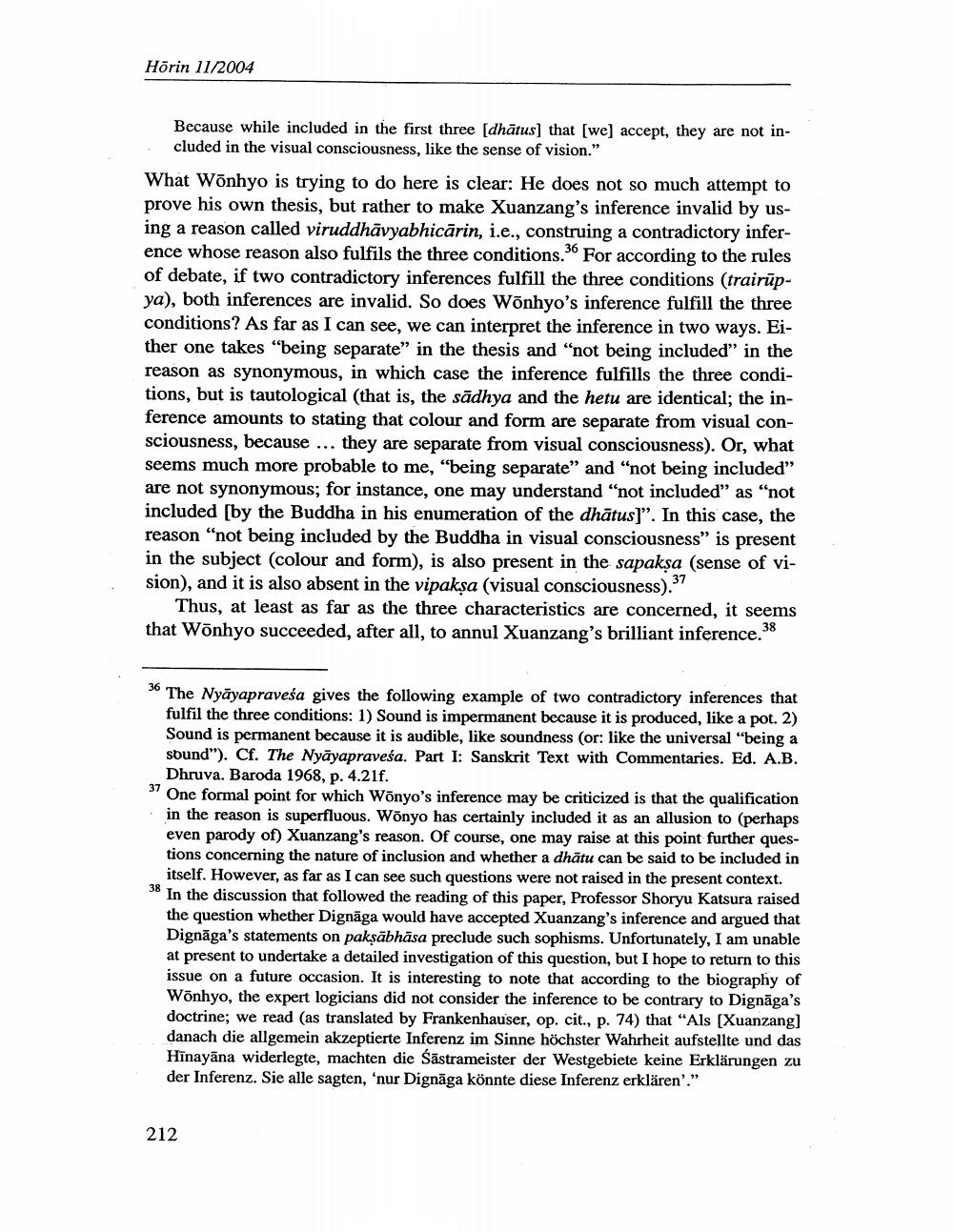________________ Horin 11/2004 Because while included in the first three [dhatus] that (we) accept, they are not in cluded in the visual consciousness, like the sense of vision." What Wonhyo is trying to do here is clear: He does not so much attempt to prove his own thesis, but rather to make Xuanzang's inference invalid by using a reason called viruddhavyabhicarin, i.e., construing a contradictory inference whose reason also fulfils the three conditions. For according to the rules of debate, if two contradictory inferences fulfill the three conditions (trairupya), both inferences are invalid. So does Wonhyo's inference fulfill the three conditions? As far as I can see, we can interpret the inference in two ways. Either one takes "being separate" in the thesis and "not being included" in the reason as synonymous, in which case the inference fulfills the three conditions, but is tautological (that is, the sadhya and the hetu are identical; the inference amounts to stating that colour and form are separate from visual consciousness, because ... they are separate from visual consciousness). Or, what seems much more probable to me, "being separate" and "not being included" are not synonymous; for instance, one may understand "not included" as "not included [by the Buddha in his enumeration of the dhatus]". In this case, the reason "not being included by the Buddha in visual consciousness" is present in the subject (colour and form), is also present in the sapaksa (sense of vision), and it is also absent in the vipaksa (visual consciousness)." Thus, at least as far as the three characteristics are concerned, it seems that Wonhyo succeeded, after all, to annul Xuanzang's brilliant inference." 38 * The Nyayapravesa gives the following example of two contradictory inferences that fulfil the three conditions: 1) Sound is impermanent because it is produced, like a pot. 2) Sound is permanent because it is audible, like soundness (or: like the universal "being a sound"). Cf. The Nyayapravesa. Part I: Sanskrit Text with Commentaries. Ed. A.B. Dhruva. Baroda 1968, p. 4.21f. 37 One formal point for which Wonyo's inference may be criticized is that the qualification in the reason is superfluous. Wonyo has certainly included it as an allusion to (perhaps even parody of) Xuanzang's reason. Of course, one may raise at this point further questions concerning the nature of inclusion and whether a dhatu can be said to be included in itself. However, as far as I can see such questions were not raised in the present context. In the discussion that followed the reading of this paper, Professor Shoryu Katsura raised the question whether Dignaga would have accepted Xuanzang's inference and argued that Dignaga's statements on paksabhasa preclude such sophisms. Unfortunately, I am unable at present to undertake a detailed investigation of this question, but I hope to return to this issue on a future occasion. It is interesting to note that according to the biography of Wonhyo, the expert logicians did not consider the inference to be contrary to Dignaga's doctrine; we read (as translated by Frankenhauser, op. cit., p. 74) that "Als (Xuanzang] danach die allgemein akzeptierte Inferenz im Sinne hochster Wahrheit aufstellte und das Hinayana widerlegte, machten die Sastrameister der Westgebiete keine Erklarungen zu der Inferenz. Sie alle sagten, 'nur Dignaga konnte diese Inferenz erklaren'." 212




